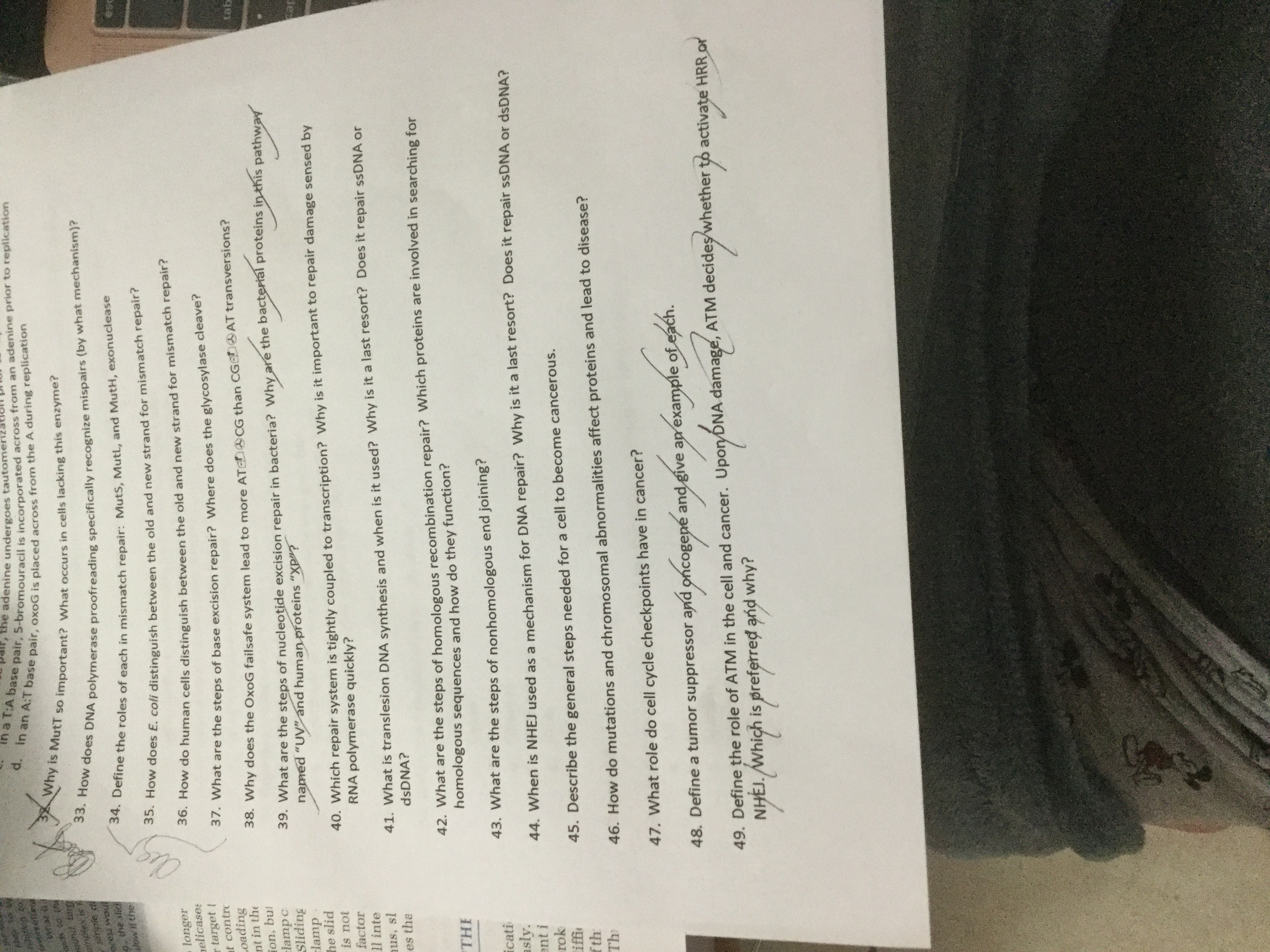
Human Anatomy & Physiology (11th Edition)
11th Edition
ISBN: 9780134580999
Author: Elaine N. Marieb, Katja N. Hoehn
Publisher: PEARSON
expand_more
expand_more
format_list_bulleted
Question
Question 45 please

Transcribed Image Text:in a T:A base pair, 5-bromouracil is incorporated across from an adenine prior to replication
the adenine undergoes tautomeriza
d. In an A:T base pair, oxoG is placed across from the A during replication
Why is MutT so important? What occurs in cells lacking this enzyme?
33. How does DNA polymerase proofreading specifically recognize mispairs (by what mechanism)?
34. Define the roles of each in mismatch repair: MutS, MutL, and MutH, exonuclease
nd targ
siiripie c
Che slic
slow if the
5. How does E. coli distinguish between the old and new strand for mismatch repair
-longer
nelicases
r target (
at contro
oading
nt in the
ion, but
clamp c
Sliding
clamp
he slid
is not
factor
1l inte
nus, sl
es tha
o. How do human cells distinguish between the old and new strand for mismatch repair?
37. What are the steps of base excision repair? Where does the glycosylase cleaver
So. why does the OxoG failsafe system lead to more ATOD CG than CGeDAT transversions?
tab
S3. What are the steps of nucleotide excision repair in bacteria? Why are the bacteriál proteins in this pathway
named "UV" and human proteins "XP"?
40. Which repair system is tightly coupled to transcription? Why is it important to repair damage sensed by
RNA polymerase quickly?
41. What is translesion DNA synthesis and when is it used? Why is it a last resort? Does it repair ssDNA or
dsDNA?
42. What are the steps of homologous recombination repair? Which proteins are involved in searching for
homologous sequences and how do they function?
THE
43. What are the steps of nonhomologous end joining?
icati
asly.
ent i
rok
liffi
fth
Th
44. When is NHEJ used as a mechanism for DNA repair? Why is it a last resort? Does it repair ssDNA or dsDNA?
45. Describe the general steps needed for a cell to become cancerous.
46. How do mutations and chromosomal abnormalities affect proteins and lead to disease?
47. What role do cell cycle checkpoints have in cancer?
48. Define a tumor suppressor and oncogene and give an example of each.
49. Define the role of ATM in the cell and cancer. o activate HRR or
UporyDNA damage, ATM decides whether to
NHÈJ. Which is preferred and why?
Expert Solution
This question has been solved!
Explore an expertly crafted, step-by-step solution for a thorough understanding of key concepts.
This is a popular solution
Trending nowThis is a popular solution!
Step by stepSolved in 4 steps

Knowledge Booster
Learn more about
Need a deep-dive on the concept behind this application? Look no further. Learn more about this topic, biology and related others by exploring similar questions and additional content below.Similar questions
- The action of the rectus abdominis is to______________________________--arrow_forwardhelp please !!!!!!! thank you in advancearrow_forwardQUESTION 36 Mr. Jones has an upper respiratory tract infection. This means he has an infection associated with the bronchioles O pleura O lungs O pharynxarrow_forward
arrow_back_ios
arrow_forward_ios
Recommended textbooks for you
 Human Anatomy & Physiology (11th Edition)BiologyISBN:9780134580999Author:Elaine N. Marieb, Katja N. HoehnPublisher:PEARSON
Human Anatomy & Physiology (11th Edition)BiologyISBN:9780134580999Author:Elaine N. Marieb, Katja N. HoehnPublisher:PEARSON Biology 2eBiologyISBN:9781947172517Author:Matthew Douglas, Jung Choi, Mary Ann ClarkPublisher:OpenStax
Biology 2eBiologyISBN:9781947172517Author:Matthew Douglas, Jung Choi, Mary Ann ClarkPublisher:OpenStax Anatomy & PhysiologyBiologyISBN:9781259398629Author:McKinley, Michael P., O'loughlin, Valerie Dean, Bidle, Theresa StouterPublisher:Mcgraw Hill Education,
Anatomy & PhysiologyBiologyISBN:9781259398629Author:McKinley, Michael P., O'loughlin, Valerie Dean, Bidle, Theresa StouterPublisher:Mcgraw Hill Education, Molecular Biology of the Cell (Sixth Edition)BiologyISBN:9780815344322Author:Bruce Alberts, Alexander D. Johnson, Julian Lewis, David Morgan, Martin Raff, Keith Roberts, Peter WalterPublisher:W. W. Norton & Company
Molecular Biology of the Cell (Sixth Edition)BiologyISBN:9780815344322Author:Bruce Alberts, Alexander D. Johnson, Julian Lewis, David Morgan, Martin Raff, Keith Roberts, Peter WalterPublisher:W. W. Norton & Company Laboratory Manual For Human Anatomy & PhysiologyBiologyISBN:9781260159363Author:Martin, Terry R., Prentice-craver, CynthiaPublisher:McGraw-Hill Publishing Co.
Laboratory Manual For Human Anatomy & PhysiologyBiologyISBN:9781260159363Author:Martin, Terry R., Prentice-craver, CynthiaPublisher:McGraw-Hill Publishing Co. Inquiry Into Life (16th Edition)BiologyISBN:9781260231700Author:Sylvia S. Mader, Michael WindelspechtPublisher:McGraw Hill Education
Inquiry Into Life (16th Edition)BiologyISBN:9781260231700Author:Sylvia S. Mader, Michael WindelspechtPublisher:McGraw Hill Education

Human Anatomy & Physiology (11th Edition)
Biology
ISBN:9780134580999
Author:Elaine N. Marieb, Katja N. Hoehn
Publisher:PEARSON

Biology 2e
Biology
ISBN:9781947172517
Author:Matthew Douglas, Jung Choi, Mary Ann Clark
Publisher:OpenStax

Anatomy & Physiology
Biology
ISBN:9781259398629
Author:McKinley, Michael P., O'loughlin, Valerie Dean, Bidle, Theresa Stouter
Publisher:Mcgraw Hill Education,

Molecular Biology of the Cell (Sixth Edition)
Biology
ISBN:9780815344322
Author:Bruce Alberts, Alexander D. Johnson, Julian Lewis, David Morgan, Martin Raff, Keith Roberts, Peter Walter
Publisher:W. W. Norton & Company

Laboratory Manual For Human Anatomy & Physiology
Biology
ISBN:9781260159363
Author:Martin, Terry R., Prentice-craver, Cynthia
Publisher:McGraw-Hill Publishing Co.

Inquiry Into Life (16th Edition)
Biology
ISBN:9781260231700
Author:Sylvia S. Mader, Michael Windelspecht
Publisher:McGraw Hill Education